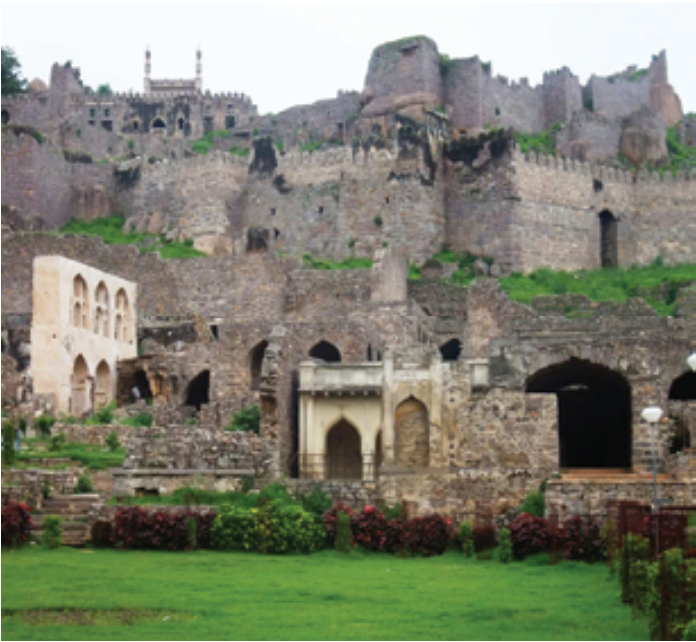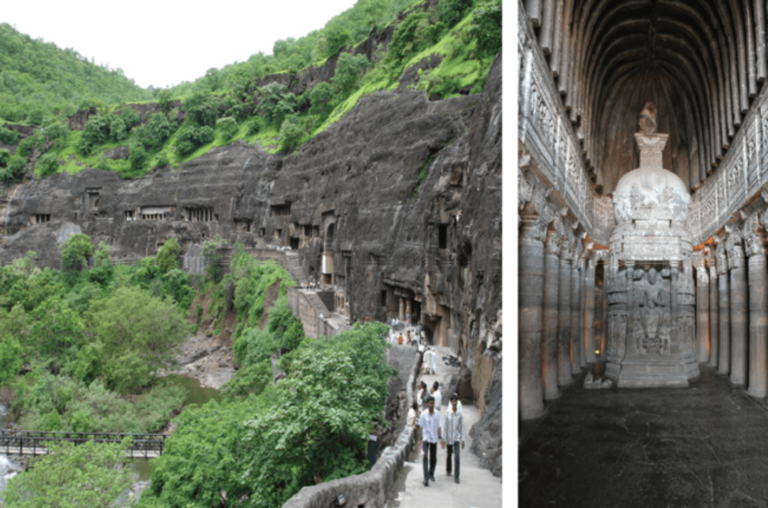Through examples, Aniruddh Kamat explains how the country’s rich legacy is a proof of its multi-splendoured history. A travel experience in India amply unravels the awe-inspiring diversity of India’s temples, forts, palaces, and monuments — a collection of marvels that bear witness to the excellence in human craftsmanship, spiritual devotion, and regal grandeur where each edifice is a classic of human effort.
India’s architectural legacy is a testament to its multifaceted history and the profound cultural exchanges that have shaped the subcontinent. Each travel experience in India unravels the awe-inspiring diversity of India’s temples, forts, palaces, and monuments—a collection of marvels that bear witness to the zenith of human craftsmanship, spiritual devotion, and regal grandeur where each edifice stands as a masterwork of human endeavour.
Among such thousands, spread across the length and breadth of India are the Ajanta and Ellora Caves, Khajuraho, Taj Mahal, Sanchi Stupa, Golconda Fort, Konark Sun Temple, Hampi, Meenakshi Temple, etc.
The temples of Khajuraho, nestled in the heart of Madhya Pradesh, made during the Chandela dynasty, stand as authentic showcases of architectural intricacy. Their sandstone facades are adorned with an astonishing array of sculptures, each chiselled with a precision and artistry that speak volumes about the skill of ancient artisans.
Khajuraho temples are among the finest examples of temple architecture in India and across the world. The depictions in the temples, celebrating human sensuality, spirituality, and daily life, transcend time and offer a window into the cultural milieu of their era.
Chola brilliance
The Brihadishvara Temple, a stunning gem of Chola architecture in Tamil Nadu, is an exemplar of structural audacity and aesthetic finesse. Its towering vimana, adorned with delicate carvings and crowned by a monolithic cupola, displays the engineering acumen of the time.
This temple, dedicated to Lord Shiva, not only serves as a spiritual sanctum but also echoes the grandeur of the Chola dynasty. Also called Rajarajesvaram by its builder and locally as Thanjai Periya Kovil and Peruvudaiyar Kovil, this temple is a Shaivite Hindu temple located on the south bank of the Cauvery River in Thanjavur.
One of the largest Hindu temples and part of the UNESCO World Heritage Site known as the ‘Great Living Chola Temples’, it was built by Chola king Rajaraja I between 1003 and 1010 CE. Other Chola-era temples Gangaikonda Cholapuram temple and Airavatesvara temple were also built in the same period.
Soaked in Dravidian architecture, the Airavatesvara Temple is dedicated to Lord Shiva and located in Kumbakonam in Thanjavur District in Tamil Nadu. It was built by Chola emperor Rajaraja II and is part of the same cluster of 18 temples. The temple has a chariot structure and houses several deities such as Brahma, Surya, Varuna, Agni, Indra, Sri Devi (Lakshmi), Ganga, Yamuna, Ganesha, Rati, etc.
Bastions of history and power
Perched majestically on the rugged hills of Rajasthan, the Amer Fort impersonates the Rajput valour and architectural magnificence. Its imposing walls, adorned with delicate frescoes and mirrored mosaics, encapsulate the regal splendour of a bygone era. Constructed with red sandstone and marble, the fort boasts of the Sheesh Mahal, or Palace of Mirrors where a single candle’s light can illuminate the entire room through thousands of tiny mirrors. The marble lattice work and the sprawling courtyards bear witness to the artistic flair that defined the Rajput architectural style.
On the other hand, the Golconda Fort, a citadel of the Deccan Sultanate, rises like an ancient sentinel in Hyderabad, Telangana. Its ingeniously-designed acoustic system, whispering galleries, and strategic layout attest to the engineering acumen of its builders. This fort, soaked in history, not only narrates the tales of dynasties but also of military engineering.
Agra Fort, is an imposing structure of red sandstone that witnessed the rise and fall of empires. Built by Emperor Akbar, it served as the seat of Mughal power for generations. The fort’s palatial halls, lush gardens, and commanding views of the Taj Mahal are a testament to the strategic foresight of the Mughal dynasty.
Chittorgarh Fort is a shining example of the powere and might of the rulers of the time. The fort’s towering walls and imposing gates guard the stories of legendary queens like Rani Padmini and Rani Karnavati. The Vijay Stambh, or Tower of Victory, rises proudly, its intricately-carved reliefs narrating the tales of victory and defeat. Each stone within the fort bears witness to the indomitable spirit of its defenders, who chose honour over surrender.
Opulence, royalty, love
The City Palace of Udaipur, Rajasthan, is nothing but royal opulence of the Mewar dynasty. Its grand courtyards, ornate balconies, and mirrored chambers reflect the artistic mastery that defined the era. This palace, nestled on the banks of Lake Pichola, captures the ethereal beauty of Rajasthan’s royal heritage.
Situated in the heart of Karnataka, the Mysore Palace is another masterpiece of the Indo-Saracenic architecture. With its domes, arches, and vibrant murals, it is sheer reflection of the refined taste of the Wadiyar or Wodeyer dynasty. Illuminated by thousands of bulbs during festivals, the palace transforms into a radiant jewel, captivating visitors with its resplendent aura.
The Taj Mahal, an iconic symbol of love and devotion, graces the banks of the Yamuna River in Agra. Commissioned by the Mughal emperor Shah Jahan in memory of his beloved wife Mumtaz Mahal, this architectural wonder is a fusion of Persian, Islamic, and Indian architectural styles. The immaculate white marble facade, adorned with floral motifs and calligraphy, evokes a sense of ethereal beauty. As the sun sets, casting a warm glow upon the mausoleum, it seems as though love itself permeates the air.

Elaborate and intricate
Located in the town of Patan, Gujarat, Rani Ki Vav is a subterranean structure that transcends mere architectural excellence. Built in the 11th century by Queen Udayamati, this stepwell is a symphony of elaborate carvings, showcasing the divine and the secular. As one descends into its depths, they are greeted by a gallery of sculptures, each telling a story of devotion, art, and societal norms of its time. Rani Ki Vav is an example of the architectural ingenuity of medieval India.
Mehrangarh Fort of Jodhpur is a behemoth of red sandstone, its walls standing tall against the sands of time. The fort’s formidable presence is matched only by the intricacy of its inner palaces. The Moti Mahal, adorned with delicately-carved lattice screens, once served as the private chamber of the Maharaja. From its vantage points, one can gaze upon the Blue City, a sea of indigo-hued houses that stretches to the horizon.
On the shores of Odisha, the Sun Temple of Konark rises like a celestial chariot, dedicated to the sun god Surya. The temple’s carvings depict not only religious motifs but also scenes of everyday life, offering a window into the society of its time. The wheels of the chariot, with their detailed spokes and engraved figures, are a marvel of engineering and artistry. As the sun casts its rays upon the temple, it seems to breathe life into the stone, illuminating the ancient craftsmanship for all to admire.
As we traverse through the architectural diversity of India, we are reminded of the need to preserve and protect these timeless marvels. They are not merely structures of stone and mortar; they are repositories of history, culture, and human ingenuity. Initiatives for restoration and conservation play a pivotal role in ensuring that future generations can experience the same beauty that has captivated us.

